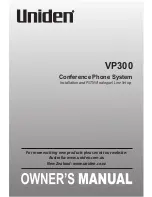
RDL-3000
FAMILY
USER MANUAL
70-00158-03-00
Proprietary Redline Communications © 2015
Page
25
of 254
April 17, 2015
2.3
PMP Mode
This section describes the parameters required to configure PMP support and an
overview of supported VLAN functions. Operation in PMP mode is controlled by the
options keys. Separate options keys are required for the sector controller and each
subscriber. Enter the options keys before deploying and configuring the RDL-3000
system.
Classification
The basic operation of the RDL-3000 is to operate as a point-to-multipoint (PMP) VLAN-
aware wireless L2 switch. Traffic is classified and processed by creating Service and
Service Group profiles to be applied to all packets received and being transmitted on the
Ethernet port of each RDL-3000. The sector controller and subscriber are configured
separately for use with VLAN tagged traffic, untagged traffic, or a combination these two
types. Multiple VLAN IDs can be configured for each port.
Each ingress and egress Ethernet packet is examined and classified according to the
VLAN ID. The matching profile and data direction determines if a VID should be added
or removed, if the packet should be forwarded unmodified (pass through mode), or if the
packet is discarded. Additional traffic controls include CIR/PIR settings to guarantee
required bandwidth.
Fig. 2: Functional Desc. - Distributed L2 VLAN-Aware Wireless Switch
Links and Services
Ethernet data traffic can not be transmitted over the wireless interface until at least one
Link, Service, and Service Group have been provisioned. All provisioning is performed
on the sector controller:
Link
: Configure the wireless link settings including the uplink and downlink uncoded
burst rates (UBR).
Service
: Define how packets are classified and processed at the subscriber Ethernet
port. Set traffic parameters for subscriber (unicast) traffic.
Service Group
: Define how packets are classified and processed at the sector
controller Ethernet port. Set traffic parameters for broadcast/multicast groups.















































